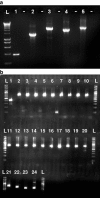Full sequencing of viral genomes: practical strategies used for the amplification and characterization of foot-and-mouth disease virus
- PMID: 19521878
- PMCID: PMC7122775
- DOI: 10.1007/978-1-60327-999-4_17
Full sequencing of viral genomes: practical strategies used for the amplification and characterization of foot-and-mouth disease virus
Abstract
Nucleic acid sequencing is now commonplace in most research and diagnostic virology laboratories. The data generated can be used to compare novel strains with other viruses and allow the genetic basis of important phenotypic characteristics, such as antigenic determinants, to be elucidated. Furthermore, virus sequence data can also be used to address more fundamental questions relating to the evolution of viruses. Recent advances in laboratory methodologies allow rapid sequencing of virus genomes. For the first time, this opens up the potential for using genome sequencing to reconstruct virus transmission trees with extremely high resolution and to quickly reveal and identify the origin of unresolved transmission events within discrete infection clusters. Using foot-and-mouth disease virus as an example, this chapter describes strategies that can be successfully used to amplify and sequence the full genomes of RNA viruses. Practical considerations for protocol design and optimization are discussed, with particular emphasis on the software programs used to assemble large contigs and analyze the sequence data for high-resolution epidemiology.
Figures




Similar articles
-
Development of a universal RT-PCR for amplifying and sequencing the leader and capsid-coding region of foot-and-mouth disease virus.J Virol Methods. 2013 Apr;189(1):70-6. doi: 10.1016/j.jviromet.2013.01.009. Epub 2013 Feb 1. J Virol Methods. 2013. PMID: 23380590
-
Simple, quick and cost-efficient: A universal RT-PCR and sequencing strategy for genomic characterisation of foot-and-mouth disease viruses.J Virol Methods. 2017 Aug;246:58-64. doi: 10.1016/j.jviromet.2017.04.007. Epub 2017 Apr 23. J Virol Methods. 2017. PMID: 28442328
-
Comparative genomics of serotype Asia 1 foot-and-mouth disease virus isolates from India sampled over the last two decades.Virus Res. 2008 Sep;136(1-2):16-29. doi: 10.1016/j.virusres.2008.04.010. Epub 2008 Jun 3. Virus Res. 2008. PMID: 18511143
-
Transmission pathways of foot-and-mouth disease virus in the United Kingdom in 2007.PLoS Pathog. 2008 Apr 18;4(4):e1000050. doi: 10.1371/journal.ppat.1000050. PLoS Pathog. 2008. PMID: 18421380 Free PMC article.
-
Laboratory Methods in Molecular Epidemiology: Viral Infections.Microbiol Spectr. 2018 Nov;6(6):10.1128/microbiolspec.ame-0003-2018. doi: 10.1128/microbiolspec.AME-0003-2018. Microbiol Spectr. 2018. PMID: 30387412 Free PMC article. Review.
Cited by
-
The Cutaneous Microbiome and Wounds: New Molecular Targets to Promote Wound Healing.Int J Mol Sci. 2018 Sep 11;19(9):2699. doi: 10.3390/ijms19092699. Int J Mol Sci. 2018. PMID: 30208569 Free PMC article. Review.
-
Whole genome sequencing and molecular detection of potato virus X in Bangladesh.PLoS One. 2025 May 8;20(5):e0322935. doi: 10.1371/journal.pone.0322935. eCollection 2025. PLoS One. 2025. PMID: 40341848 Free PMC article.
-
Experimental Infection Models and Their Usefulness for White Spot Syndrome Virus (WSSV) Research in Shrimp.Viruses. 2024 May 20;16(5):813. doi: 10.3390/v16050813. Viruses. 2024. PMID: 38793694 Free PMC article. Review.
-
Current Trends in Diagnostics of Viral Infections of Unknown Etiology.Viruses. 2020 Feb 14;12(2):211. doi: 10.3390/v12020211. Viruses. 2020. PMID: 32074965 Free PMC article. Review.
References
Publication types
MeSH terms
Substances
Grants and funding
LinkOut - more resources
Full Text Sources
Other Literature Sources

